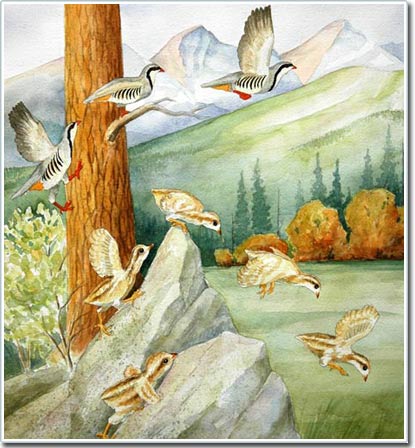How do birds learn to fly?
According to a new study, young birds may have to learn how to master the opening angle of their wings to become good flyers. This result can be used to explore the origin of flying ability.
Kenneth Dial, University of Montana and colleagues previously recorded how birds climb up vertical stems, rocks or cliffs by adjusting the opening angle of the wings to create wind forces that hold them to the ground. Even young birds use their growing wings to create miracles. Newborn birds have matured at an open angle of 60o from the beginning and they deal with wider challenges in a dangerous period before they can fly.
Dial explained: 'The wings were able to operate immediately after the newly hatched bird had a particularly important meaning.'
His team discovered the secret behind this and the flying ability began by learning the skill of creating the angle between the wings and the ground to create force . It seems that both young and adult birds use the same angle for different types of movements to take off.
Great importance
The study is published in the latest edition of Nature. This is an important study to investigate the behavior of current birds.
Dial said: 'Birds often use completely undeveloped wings to improve their movement and escape enemies. Even if we do not mention the conclusion about evolution, its influence on the ecosystem is also quite important. '

The way the young birds fly depends on how they grasp the opening angle of the wing.This is an illustration of Chukar chicken.The new study suggests that although the take-off place is different, its opening angle is always the same.(Photo: National Geographic)
Kevin Padian, expert on the origin of flying abilities at the University of California, Berkeley, said this work is important for flight theory.'This is a great discovery. For me, it means that birds always 'move forward' whether flying or climbing trees. So the angle of the wings at attack may be similar or almost the same. '
The main author of the project - Dial, hopes to observe the different wings for different activities through the study of chukar, a bird that cannot fly similar to live quail. in Eurasia.'They really only need one wing and they use their wings as soon as they hatch in a way that makes sense in terms of aerodynamics even though they can't fly.'
How vulnerable young birds use wings during adulthood can serve as a model for bird ancestors to develop their flying abilities.
Dial said: 'If we look back at the fossils they are looking for, the half-winged long-legged dinosaurs look like birds that are now grown up strangely. As you follow the development of these species, you are probably observing the strategies that their ancestors used to overcome transitional periods in evolution. '
Scientists have long debated the two assumptions of the origin of flying abilities: The assumption from the tree species suggests that the ancestors of birds live on trees, jump, glide and eventually from one branch to the other. The rest is adaptive theory, thinking that the scales on the front legs gradually become feathers and eventually raise the reptile from the ground.
Dial said: 'This hypothesis means that newborn wings are probably an explanation for the evolution of flying ability. There is no reason to talk about which birds start from which environment they need to understand how they adapt to their habitats. '
Padian agrees with the above opinion.'Opposition opinions have existed for too long and old. The question now is how the takeoff evolves. No one can fly without forming a takeoff. Many species live on trees, even capable of gliding but have never been able to fly. '
- Migratory birds learn
- Study birds to discover how children learn to speak
- How do birds learn to sing?
- Baby birds also babble before singing
- Birds never ... fly
- How does the dinosaur learn to fly?
- Unbelievable records of birds
- The weird tricks of the
- The flock of birds appears in Lao Cai as a swallow
- Why do birds have no teeth?
- 10 species of birds have beautiful long tail feathers
- Sky bird - unpredictable danger for aviation
 Animal 'suffering' after hibernation
Animal 'suffering' after hibernation Why do goats climb well?
Why do goats climb well? Scientists were surprised to see chimpanzees eating turtles
Scientists were surprised to see chimpanzees eating turtles Giant catfish died deadly due to drought in Thailand
Giant catfish died deadly due to drought in Thailand